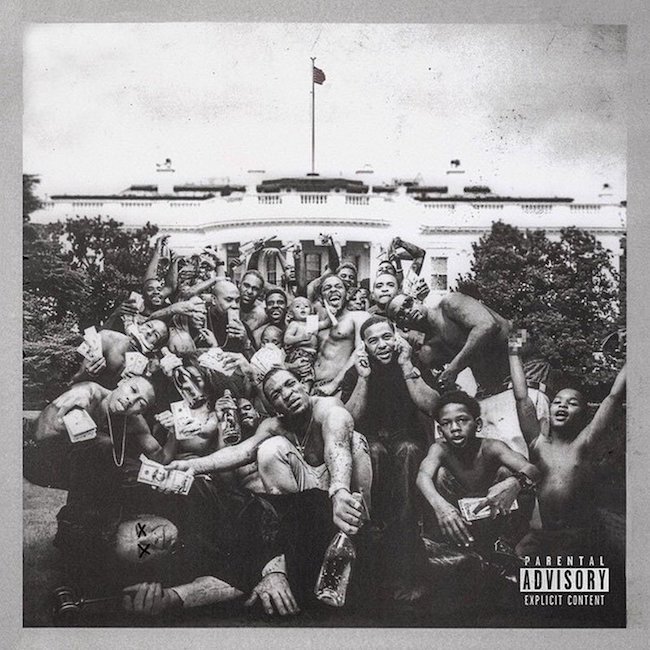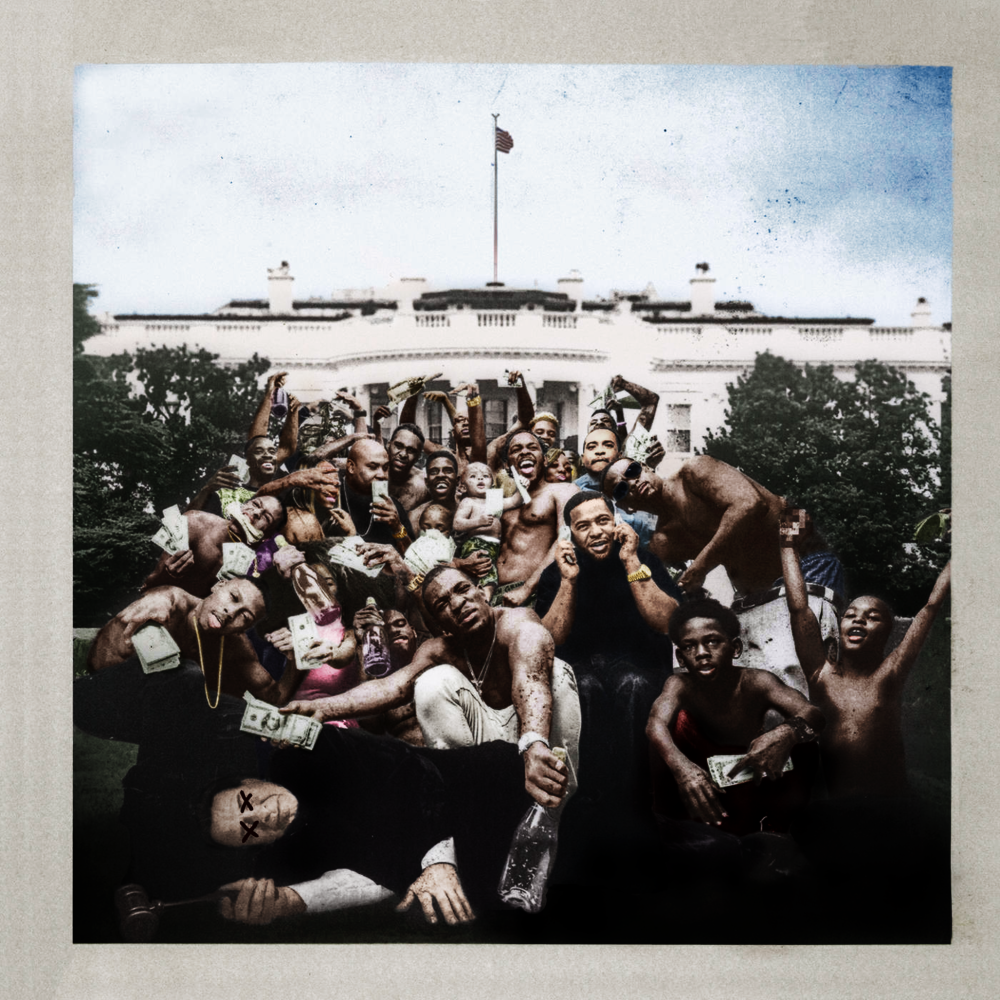Before you lies an explication of a(n) [black] artist’s work, which came to the world in the form of music. More notably, hip-hop. The artist, popularly known as Kendrick Lamar, created this album for a specific purpose, for a particular audience, and within a specific time and context (kairos). What this series of blog posts will do will attempt to delve into the art itself to uncover silent or boisterous narratives. In doing so, the hope is that this explication will be the potential catalyst for a shift in paradigm for members who are consciously, socio-economically, physically, and emotionally, in many ways, separated from the Black community.

Photo courtesy of GOOGLE at https://uproxx.files.wordpress.com/2016/11/kendrick-lamar-tpab.jpg?quality=100&w=650
Lamar, as a rhetor offers commentary on the world, more specifically the American society and its effect on the expression and survival of Blackness. The album of the photo posted above is titled To Pimp a Butterfly (subsequently will be referred to as TPAB), is wrought with many meanings, depending on who you are and how you perceive the world. For the purpose of this explication, the meaning of the title will be unfurled once the sum of its parts (the sixteen tracks that comprise the project) and their respective meanings have been expounded upon. I am designing my Rhetorical Analysis this way because I feel that until one understands the components of a work, they cannot hope to have a full understanding of the work itself. Situating the work in its original context will also aid in a comprehensive understanding of the work.
The Artifact
In essence, this rhetorical analysis will feature the explication of a text (the album) sonically as music, literally as a text, and visually as the album cover. Starting with the what is the first presentation of a sonic body of work, the album cover of any album says something. Now, let’s begin with that Kendrick Lamar is attempting to say. I chose to present a colorized version of the album cover in order to see smaller details more clearly than presented in the original cover, which is black and white.

Photo courtesy of Pinterest at https://www.pinterest.com/pin/732538695609929422/?autologin=true
Where does one start in the analysis of such a powerful image? The actors involved in the art itself, the people and their positioning. From an initial glance, From my count, there are twenty-one African-Americans, primarily, and two White people. One of the latter, phenotypically speaking, is a baby and the other a presumably middle-aged man. the adult male is depicted loosely clutching a gavel, signifying his potential involvement in the Judicial system somehow. It appears that the connection is most likely that the middle-aged man is a judge. But, we do not know high up this man serves. The judge is seen with an “X’ over his eyes, which suggests that he has been rendered incapacitated somehow, maybe even killed. Is that child kin to the slain judge? How was the judge overcome? The twenty-one Black bodies stand over this slain symbol of the justice system overcome with smiles and other gestures (the middle finger, holding bottles of alcohol, and bundles of cash) denote a celebration of some sort. All the while, everyone is posed on against the backdrop of the White House, which could be seen as a symbol of oppression. Everyone is poised, more-or-less, for what looks like it could be a family or group photo. Situated amidst the triumphant celebration, is Kendrick Lamar, both artist, and rhetor, holding the White baby in his arms as the child imitates the celebration that the African-Americans are engaged in. Fifteen of the twenty-one bodies situated in the photo are Black males, notably shirtless. What do these shirtless Black males represent? Societal customs deem that clothes are a necessary requirement for the civilized citizen. I think we as Americans will find scarce depicitions, outside of the realm of advertisement, of the Ideal of civilized and successful Americans shirtless. The clothing resting on the many bodies in this photo give visual clues to the socioeconomic status. Poor people cannot afford clothes, the affluent can. A poor person’s wardrobe would most likely not consist of formal attire such as collared shirts, suits, ties, and formal career-specific apparel (e.g., a judge’s robe and gavel). This begs the question, who supplied the bundles of cash for the group? My educated guess, the celebrity situated at the epicenter not holding money. Kendrick Lamar is the supplier of financial freedom and resources for those closest to him; this can possibly be extrapolated to the black community surrounding Kendrick, not just a few.
It is my belief that the message being portrayed in this album cover is one of a reversal of fortune. The Justice system has been seen within the Black community, primarily, as an abuser of the innocent within communities, more specifically the Black community. Many members of the African-American community have been systemically oppressed by the system itself. Historically speaking, disenfranchised from voting at one point in time, terrorized by hateful organizations (I.e. KKK), and have had their lives limited by laws and regulation sanctioned by the government itself and agent of the organization (politicians). Slave codes, gerrymandering districts and creating color lines to separate the poor and the rich. Situating this album cover within the context of the time, the year 2015 was the site of social upheaval at the killing of unarmed Black citizens at the hands of policemen. Many of the accused officers of the law were later acquitted for their crimes against their fellow citizen. Is it just one sect of the Black community that’s victimized? Has the bloodshed been primarily of the denizens of poor communities or the wealthy within the Black community? Who’s safe and who isn’t? This powerful artifact created by Kendrick Lamar depicts the death of a system that oppresses Black bodies, the death of a system that has perpetually ‘pimped’ these ebony-hued beings to its economic benefit. As he holds a symbol of the youth in his hands, his words, thoughts, and influence are closest to the ear of the youth, more importantly, the white youth. Who, over time due to the rapid commercialization of hip-hop have profited more from the stories of trials and triumph than the Black artists that created them. I believe Kendrick’s perceived audience is much wider than just that of the Black community. K. Lamar wants to reach everyone living underneath the reach and influence of this system.
Reply to Thick Description/Introduction:
One thing I have always had a concern over is the societal definition of being “black” apart from those physiological elements of ethnicity that are distinct and different…diverse. A societal construct of the definition of “blackness” will leave many who are genetically described as such yet may have lived in an environmentally different experience from that of other (I will refrain from saying the majority of) African Americans.
I go so far as to ask the following questions to “go against the grain”.
Who defines the constituents of the black community?
Who defines what it means to be “black”?
Can someone state that you are not behaving or “acting” black?
If you still disagree with the visual representations in the cover, are you not sympathetic to the overall message the medium?
Just musing…
Do you think that your prior knowledge of the content on the album influenced your interpretation of the album cover? As someone who has not heard the album or any of Lamar’s music, it seems like a lot of what you are saying in this opening are your own personal interpretation. For me, and to help my understanding of what you’re saying and to better believe you-I think it would be helpful to include some of the evidence that you include in pt. 1, in this opening introduction. Not only evidence from the album itself but also outside sources, so that I as the reader will be readier to receive what you are saying. I think it was a very smart move to include the picture in color as well as in black and white. At first glance I did not notice that there were any white people in the picture; why do you think Lamar chose to go with the black and white version on the actual cover? Could he possibly be making reference to the past with this decision? This is such an amazing artifact to analyze. It is extremely persuasive on its own. How do you think it could effectively persuade the white community?
“As he holds a symbol of the youth in his hands, his words, thoughts, and influence are closest to the ear of the youth, more importantly, the white youth … I believe Kendrick’s perceived audience is much wider than just that of the Black community. K. Lamar wants to reach everyone living underneath the reach and influence of this system.”
I thought your take on the symbolism of the baby and Kendrick’s intended audience was particularly interesting. The word “impressionable” came to my mind. A baby is a developing being. They are experiencing and learning new things constantly. I think you made a great point by mentioning Kendrick’s desire to educate and influence the youth, specifically the white youth. I think you may also want to consider the contrast between the baby and the judge. Is the judge incapacitated or dead because of his lack of impressionability – his inability to learn and expand his views outside of systematic oppression? Do the baby and the judge symbolize two extremes – openmindedness and closedmindedness?
Overall, I think you have done well in creating an insightful analysis of the album cover!